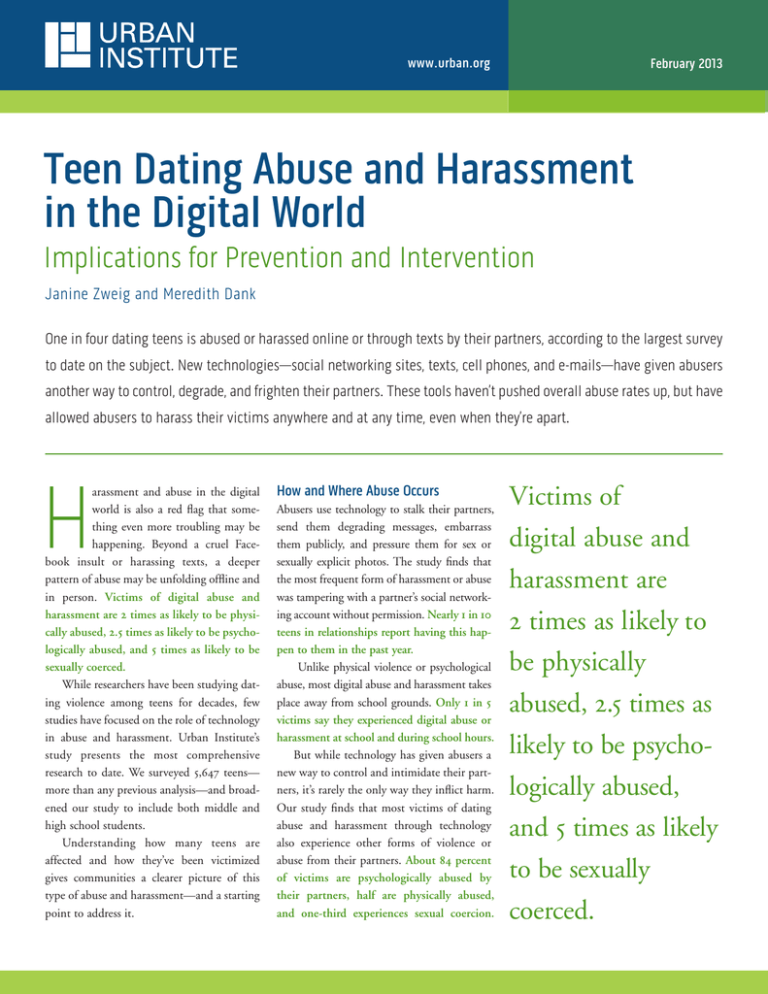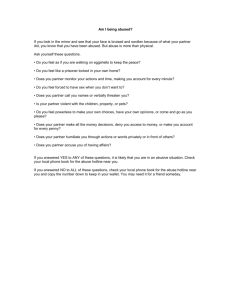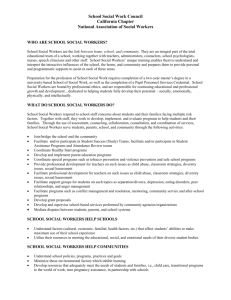
www.urban.org
February 2013
Teen Dating Abuse and Harassment
in the Digital World
Implications for Prevention and Intervention
Janine Zweig and Meredith Dank
One in four dating teens is abused or harassed online or through texts by their partners, according to the largest survey
to date on the subject. New technologies—social networking sites, texts, cell phones, and e-mails—have given abusers
another way to control, degrade, and frighten their partners. These tools haven’t pushed overall abuse rates up, but have
allowed abusers to harass their victims anywhere and at any time, even when they’re apart.
H
arassment and abuse in the digital
world is also a red flag that something even more troubling may be
happening. Beyond a cruel Facebook insult or harassing texts, a deeper
pattern of abuse may be unfolding offline and
in person. Victims of digital abuse and
harassment are 2 times as likely to be physically abused, 2.5 times as likely to be psychologically abused, and 5 times as likely to be
sexually coerced.
While researchers have been studying dating violence among teens for decades, few
studies have focused on the role of technology
in abuse and harassment. Urban Institute’s
study presents the most comprehensive
research to date. We surveyed 5,647 teens—
more than any previous analysis—and broadened our study to include both middle and
high school students.
Understanding how many teens are
affected and how they’ve been victimized
gives communities a clearer picture of this
type of abuse and harassment—and a starting
point to address it.
How and Where Abuse Occurs
Abusers use technology to stalk their partners,
send them degrading messages, embarrass
them publicly, and pressure them for sex or
sexually explicit photos. The study finds that
the most frequent form of harassment or abuse
was tampering with a partner’s social networking account without permission. Nearly 1 in 10
teens in relationships report having this happen to them in the past year.
Unlike physical violence or psychological
abuse, most digital abuse and harassment takes
place away from school grounds. Only 1 in 5
victims say they experienced digital abuse or
harassment at school and during school hours.
But while technology has given abusers a
new way to control and intimidate their partners, it’s rarely the only way they inflict harm.
Our study finds that most victims of dating
abuse and harassment through technology
also experience other forms of violence or
abuse from their partners. About 84 percent
of victims are psychologically abused by
their partners, half are physically abused,
and one-third experiences sexual coercion.
Victims of
digital abuse and
harassment are
2 times as likely to
be physically
abused, 2.5 times as
likely to be psychologically abused,
and 5 times as likely
to be sexually
coerced.
Teen Dating Abuse and Harassment in the Digital World
How Teens Get Abused and Harassed through Technology
• Used my social networking account without permission:
reported by 8.7% of teens in relationships
• Sent me texts/e-mails/etc. to engage in sexual acts I did not want: 7.4%
• Pressured me to send a sexual or naked photo of myself: 6.8%
• Sent threatening messages to me: 6.1%
• Sent me so many messages it made me feel unsafe: 5.5%
• Posted embarrassing photos of me online: 5.5%
• Wrote nasty things about me on his or her profile page: 5.1%
• Spread rumors about me using a cell phone/e-mail/a networking site, etc.: 5.0%
• Made me afraid when I did not respond to my cell phone/texts/etc.: 4.2%
• Sent sexual or naked photos I did not want: 3.8%
• Used information from my social networking site to harass me: 3.7%
• Sent me instant messages or chats that made me feel scared: 3.4%
• Used a cell phone/text/etc. to threaten to harm me physically: 2.7%
• Took video of me and sent it to his or her friends without my permission: 2.6%
• Threatened me if I did not send a sexual or naked photo of myself: 2.6%
• Created a profile page about me knowing it would upset me: 1.3%
Only 4 percent experience digital abuse and
harassment alone. So social media, texts, and
e-mails don’t seem to invite new abuse, they
just provide abusers with a new tool.
What Educators, Parents, Advocates,
and Teens Should Know
Students, parents, and school officials should
be aware that any teen can be a victim of dating abuse and harassment through technology.
Victims include girls and boys, middle school
and high school students, and teens of all
races and sexual orientations. What they have
For more information:
www.urban.org/digitizingabuse
UrbAn InSTITUTE
2100 M Street, nW ● Washington, DC 20037-1231
(202) 833-7200 ●
paffairs@urban.org ● www.urban.org
in common is that few victims seek help or
report being abused. When they do, they are
more likely to go to their friends for help.
What can be done to stop this abuse and
harassment and help victims? The answer isn’t
shutting down social media sites or taking away
teens’ cell phones. While technology may open
up avenues for dating abuse and harassment, it
can also provide the most effective solutions to
prevent it. These same digital platforms can be
tools to educate teens, spread the word about
where to go for help, and give victims and witnesses a safe way to report abuse.
Outreach is critical. Teens may not understand that dating abuse comes in different
forms besides physical violence. Parents,
teachers, principals, and peer leaders should
raise awareness about the behavior that counts
as abuse and harassment and the importance
of seeking help. School faculty and staff
should be trained to identify dating harassment and abuse and know how to help victims.
And schools with computer labs should train
teachers and students to block screen names,
apply filters, and take other protective measures to discourage online abuse.
Because victims are more likely to go to
friends for help or advice, schools might create peer groups to tell other students about
dating abuse and harassment and to offer victims a comfortable place to report incidents.
Parents should also learn how to spot red
flags. Online abuse may be harder to spot than
physical abuse. Parents should be aware of how
often teens communicate with their partners
and should talk with them about the nature
and content of the messages they receive.
Technology, particularly social networking sites and cell phones, plays a central role
in teens’ lives. It may evolve and change, but
it is not going away. We need to know if experiencing particular forms of abuse through
technology signals escalating violence in relationships. What puts youth at risk? And what
causes abusers to carry out this behavior?
Learning more will inform prevention and
intervention programs that work to stop dating abuse and harassment. •
Copyright © February 2013
This project was supported by Award No. 2010-wg-bx-003, awarded by the National Institute
of Justice, Office of Justice Programs, U.S. Department of Justice. The opinions, findings, and
conclusions and recommendations expressed in this document are those of the authors and do not
necessarily reflect those of the Department of Justice, or of the Urban Institute, its board, its
sponsors, or other authors in the series. Permission is granted for reproduction of this document,
with attribution to the Urban Institute.





